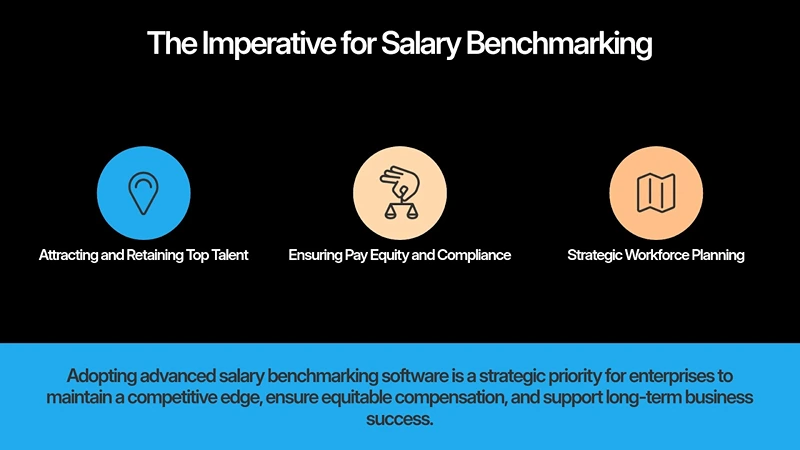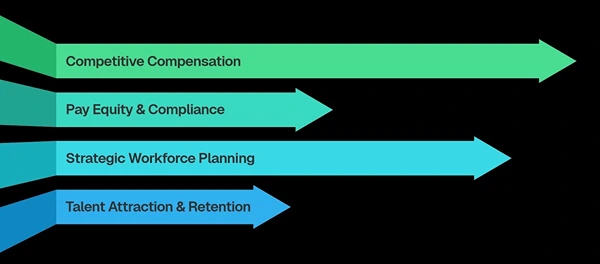- What Exactly is Salary Benchmarking Software?
- The Imperative for Salary Benchmarking in Today's Market
- Why is Salary Benchmarking Essential for Enterprises?
- Features of Modern Salary Benchmarking Tools
- How Salary Benchmarking Tools Help Attract Top Talent
- The Impact of Salary Benchmarking to the Success of an Organization
- Ensuring Pay Transparency with Benchmarking Software
- JobsPikr: Your Partner in Effective Salary Benchmarking
- Real-Life Impact: Enterprise Success Stories
- Overcoming Challenges in Salary Benchmarking
- Future Trends in Salary Benchmarking Software for 2025 and Beyond
- Why Salary Benchmarking is Vital for Competitive Compensation
Navigating the complexities of modern compensation In the landscape of 2025, setting competitive and equitable salaries has become a multifaceted challenge for enterprises. The convergence of remote work, global talent pools, and evolving employee expectations necessitates a strategic approach to compensation. Enterprises are increasingly turning to salary benchmarking software to navigate these complexities, ensuring their compensation strategies are data-driven, fair, and aligned with market trends.
Indeed, one survey estimates that employees seeking new opportunities primarily do so because they are unsatisfied with their current compensation. Salary benchmarking software allows corporations to manage these issues effectively by ensuring spending transparency while maintaining market competition.
What Exactly is Salary Benchmarking Software?
Salary benchmarking software is a digital tool that provides enterprises with accurate, real-time salary benchmark data. It compares internal compensation structures against market rates, industry standards, and even regional trends. This software goes beyond simple pay comparisons, offering deep analytics and actionable insights, helping HR teams and compensation managers make informed decisions.
At the fundamental level, salary benchmarking software allows businesses to recognize how their compensation structures measure up against those of competitors within the market. Driven by algorithms far more sophisticated than industry averages or obsolete surveys, these tools provide real-time and accurate data to enable corporate decisions to be made ahead of competitors.
The Imperative for Salary Benchmarking in Today’s Market

Attracting and Retaining Top Talent
In the case of very competitive markets, having an appropriate salary structure pegged to the industry is extremely critical. Based on a Robert Walters study in 2025, 56% of employees expect some increase in salary while 74% of them claimed that they are open to new job positions. This displays the competitiveness of the compensation framework as the primary source of fueling business growth and talent acquisition.
Ensuring Pay Equity and Compliance
Pay equity, compensation discrimination, and organizational pay gaps top the value list. Fulfilling these goals to maintain a competitive advantage requires the proper tools for measuring pay equity gaps. Such measures support compliance with the dynamically changing laws and help cultivate a positive image of an organization. The Society for Human Resource Management regarding the transparent payment contracts claimed that they are vital for the preservation of trust and confidence from employees and shielding themselves from legal litigations. Workforce Insights & Trends
Strategic Workforce Planning
Knowledge on the region’s pay market assist in budgeting and financial prediction exercises. This allows an organization to plan well in advance to engage the employees as well as prepare for volatile changes in the market. Availability of timely information enables the Human Resource Managers make decisions that are not only timely but also strategically aligned with the organizational set objectives and industry standards.
Why is Salary Benchmarking Essential for Enterprises?
The importance of salary benchmarking has grown in the past few years. Once getting compensation attracted talent, it is now a bare minimum. An SHRM study found 63% of employees selected compensation as their primary factor impacting job satisfaction and career choices. Therefore, receiving verified compensation data has become a high level priority.
Salary benchmarking serves to achieve internal equity within the enterprise. When employees feel their compensation is fair, their productivity and morale improves. Enhanced productivity alone does boost bottom lines, transparent benchmarking of salaries builds trust, resolving competitions of internal conflicts enhances employee satisfaction.
Features of Modern Salary Benchmarking Tools
Real-Time Salary Benchmark Data
Modern tools provide up-to-date information on salary trends across industries and regions. This real-time data ensures that compensation decisions are based on current market conditions, not outdated reports. With resources like Ravio that integrate with HRIS directly and offer information that is relevant to the region and industry, data driven strategies can now be employed .
Real-time salary benchmark databases such as Ravio change how businesses use information to develop compensatory strategies. Modern benchmarking software goes beyond static surveys collecting and analyzing market data almost instantly, reacting to dynamically changing environments as fast globalized compensatory managers demand.
Now that businesses have access to real-time salary benchmarking data, they are able to adjust their payment structures to reflect current market conditions. For example, if there is an industry-wide increase in salary for certain sought-after positions in technology, HR departments are able to respond quickly. This approach guarantees that employers will not be blindsided by sudden changes in the labor market.
Customizable Reports
Advanced salary benchmarking software offers customizable reports, allowing HR professionals to analyze data specific to roles, locations, and experience levels. This granularity supports more precise compensation strategies, enabling organizations to tailor their approaches to specific needs and objectives.
Integration with HR Systems
Seamless integration with existing HR platforms ensures that benchmarking data is readily accessible, streamlining the compensation planning process. This integration facilitates efficient data management and supports comprehensive compensation strategies that are both agile and responsive to market changes.
How Salary Benchmarking Tools Help Attract Top Talent
As far as the recruitment landscape is concerned, high-level professionals not only care to look at job descriptions and company culture but also the advertised overall package. With the use of salary benchmarking tools, businesses are able to make offers that will appeal strongly to the workers they really want to hire.
A tech company, for example, realized that the compensation on offer for their software engineers was 15% lower than what competitors were paying when they used salary benchmarking tools. The company then adjusted their compensation packages, which significantly improved their ability to attract talent. This example demonstrates why employers invest in sophisticated salary benchmarking tools: to improve their ability to attract and retain top talent.
The Impact of Salary Benchmarking to the Success of an Organization
Increasing Employee Satisfaction
Employees will become more engaged at work if they feel that their salaries are reasonable and their effort is valued. With the aid of benchmarking tools, organizations are now able to set market-driven salaries which enhances the employees’ satisfaction and increases retention strategies. As was reported by BambooHR, 66% of employees are dissatisfied with their pay. Workforce Insights & Trends
Supporting Diversity and Inclusion Initiatives
Benchmarking software is useful in promoting pay equity and achieving diversity as it draws attention to the gaps in remuneration practices. Equitable policies in compensation provide proof of fairness and enhance organizational branding as an inclusive employer.
Informing Compensation Strategy
With the actionable insights provided by benchmarking tools, organizations are able to develop multi-faceted compensation plans that meet the expectations of the business and takes into account prevailing market conditions. This ensures that compensation practices remain relevant and aligned with organizational objectives as well as transitioning employment market conditions.
Ensuring Pay Transparency with Benchmarking Software
Transparency in pay structures has become more than just a trend—it’s a workforce expectation. Salary benchmarking software plays a crucial role in fostering transparency within enterprises.
When employees know their pay aligns with market standards, they are less likely to feel undervalued or unfairly compensated. Salary benchmarking tools provide clear, understandable data that HR teams can share with employees to explain pay decisions. As a result, trust between employees and management grows stronger, improving overall workplace satisfaction and reducing employee turnover.

JobsPikr: Your Partner in Effective Salary Benchmarking
When it comes to reliable salary benchmarking solutions, JobsPikr comes on top. The enterprise’s vision on redefining business strategy relies on ensuring fair, equitable, and non-discriminatory payment processes achieved through the application of JobsPikr’s salary benchmarking software.
Empowering enterprises to streamline their compensation strategies with precision and flexibility is JobsPikr’s value-driven differentiator. Through artificial intelligence, accurate and up-to-date manually verified payment metrics are provided across industrial and geographical divides, granting enterprises the ability to sharpen their payment policies swiftly and effectively.
Real-Life Impact: Enterprise Success Stories
Many enterprises have experienced tangible advantages from employing the JobsPikr salary benchmarking tool. One large retail enterprise discovered that their management level salaries were about 20% behind the market rate through JobsPikr’s insights. Retention rate improved by almost 35 percent within one year after amending the compensation structure based on these insights.
Another business in the technology sector used JobsPikr to find gaps in the salaries of their remote employees. The reduction of attrition gaps after changing these rates to real-time market data was significant, highlighting the return on investment from the use of the salary benchmarking software.
Overcoming Challenges in Salary Benchmarking
Finding a solution for a challenge does not mean it is all smooth sailing afterward. The same goes for salary benchmarking; it has its own set of challenges, such as data accuracy, intricacy of integration, and timely delivery of insights. Advanced salary benchmarking software like JobsPikr, however, handles these problems with precision by providing accurate, continuously updated data with intuitive interfaces and seamless integration with HR systems.
There are numerous ways to use benchmarking technologies to enhance organizational strategies to improve decision-making processes in compensation, provided the challenges highlighted above are resolved.
Future Trends in Salary Benchmarking Software for 2025 and Beyond

Looking ahead to 2025 and beyond, salary benchmarking software will evolve with the advancement of artificial intelligence and machine learning technologies. Predictive analytics, when aligned with these technologies, will offer enhanced responsiveness, rather than mere reactive capabilities.
Businesses in 2025 will harness the power of foresight tools predicting compensation trends years in advance, allowing for much greater attention to be paid to proactive HR planning. In addition, the shift to predominantly remote and hybrid working models will enable global benchmarking software to capture subtleties at micro dimensions of compensation practices across territories, allowing businesses to maintain a competitive edge outside their geographical locations.

Why Salary Benchmarking is Vital for Competitive Compensation
In the current business environment where talent is scarce and highly competitive, enterprises cannot afford to be reckless with the compensation strategies they choose to adopt. Benchmarking studies indicate that organizations with well-defined benchmarks outperform their counterparts by experiencing up to 30% higher employee retention rates. Furthermore, 78% of surveyed HR professionals report greater employee morale and satisfaction as a result of salary benchmarking.
Using high-quality salary benchmarking tools such as JobsPikr ensures that businesses remain compliant, equitable, and competitive in the marketplace. Corporations that consistently adjust internal compensation frameworks in alignment with external market benchmarks dynamically positioned themselves to attract, retain, and motivate the most sought-after talent, which is critical in outperforming competition. Adopting salary benchmarking is not just a human resource best practice; it becomes a strategically vital enabler for securing a sustained competitive advantage for long-term business prosperity in 2025 and beyond.If you’re ready to build a smarter compensation strategy powered by real-time labor market insights, sign up on JobsPikr and get access to data that helps you set pay with confidence.




